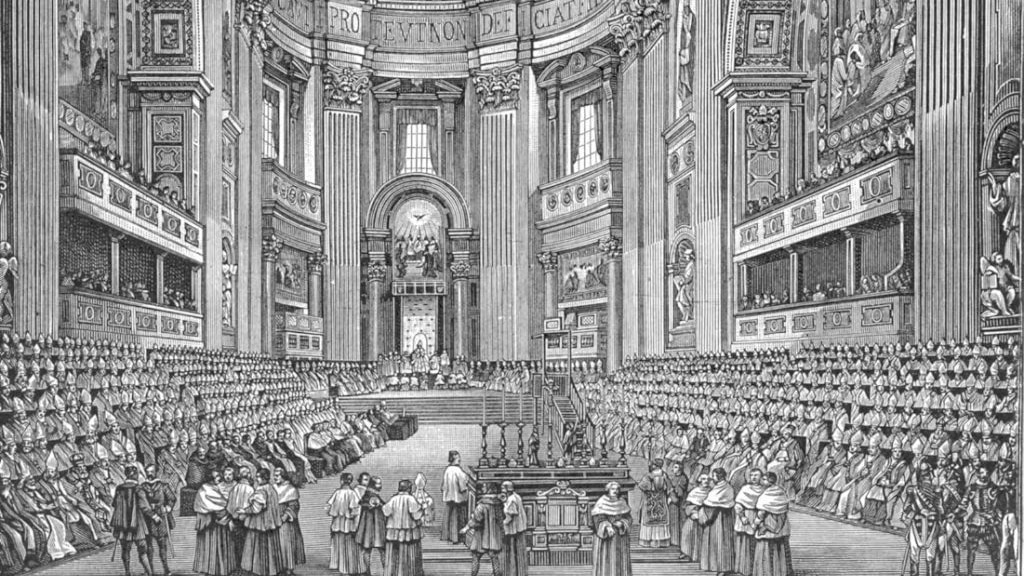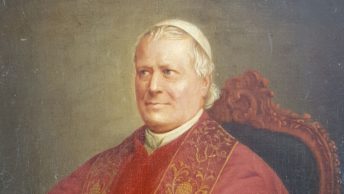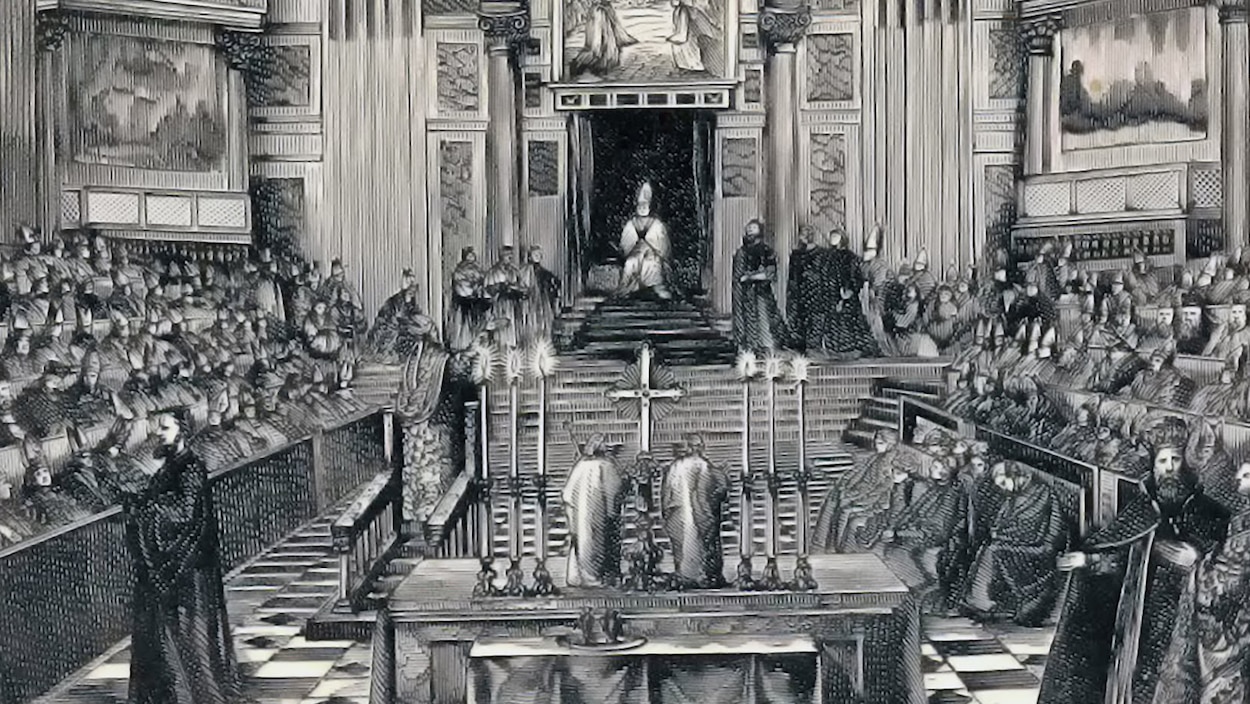Part 1 discussed the origin of the doctrine of Papal Infallibility in the first Vatican Council (1869-1870), as well as relevant documents produced more recently. That discussion closed with an expression of wonder about the intellectual and spiritual climate at the time of Vatican I, the theological differences of those in attendance, the various pressures they felt, the opposing arguments that filled the Council sessions, and the impact of those arguments on the outcome of the Council. Part 2 discusses these matters.
The doctrine of Papal Infallibility resulted from the deliberations of the first Vatican Council, and the arguments that shaped the doctrine’s form and expression are detailed in Part 1 of this essay. Those arguments were not unanimously embraced, however. A strong and vocal minority offered what they considered compelling counter-arguments. Our understanding of the doctrine of infallibility is not complete until we become familiar with those dissenting views. This essay will focus on three of them: American Archbishop Peter Kenrick’s, Bosnian Bishop Joseph Strossmayer’s, and Catholic historian Lord Acton’s. Before turning to those views, however, it may be helpful to understand the milieu in which the Council took place.
In the thirty years before the opening of the first Vatican Council in 1869, ten major wars were fought in the western world, nine in Europe and one (the Civil War) in America. And intellectual turbulence was no less a problem. In the 1860s. numerous philosophies were in competition, some full-blown, others nascent. The list included Marxism, Darwinism, Anarchism, Socialism, Communism, Romanticism, Relativism, and Modernism. A common theme in all of them was rejection of traditional authority, especially religious authority. Adding to the negative sentiment toward religion was outrage over the 1864 issuance of the Syllabus of Errors and the 1867 announcement that Spanish Inquisitor Pedro de Arbués would be canonized.
During this period the Catholic Church was under siege and its bishops were understandably concerned about the impact of increasing rejection of authority on the faith of Catholics around the world. A key question was how the authority of the Church could be restored, and the doctrine of infallibility seemed to many prelates the perfect answer because it not only reasserted the Church’s authority in faith and morals, but also did so in a way that would (at least in theory) end all subsequent debate. In other words, the new doctrine promised to give dramatically new meaning to the older declaration, Roma locuta est, causa finita est—“Rome has spoken, the matter is settled”.
Understood in that way, the doctrine of infallibility seemed beyond challenge. So why was it so controversial, and what exactly did the dissenters have to say against it?
Bishop Strossmayer delivered his dissenting view in a 6000 word presentation to the Council. He began by explaining that he had carefully searched the Bible and found “not one single chapter, or one little verse [in the New Testament], in which Jesus Christ gives to St. Peter the mastery over the apostles, his fellow workers.”
“While we teach that the Church is built upon St. Peter,” the bishop continued, “St. Paul . . . says, in his epistle to the Ephesians 2:20, it is built on the foundation of the apostles and the prophets, Jesus Christ Himself being the chief cornerstone.” He added that St. Paul made “no mention . . . of the primacy of St. Peter,” and neither did Saints John, James, or Luke. “What surprised [him] most,” however, was “the silence of St. Peter” in the matter.
Strossmayer then explained that when he extended his search beyond the age of the apostles into the first four centuries, he again found nothing that would support the primacy of Peter, adding this clarification: “I confess without difficulty that the Patriarch of Rome held the first place . . . [But] precedence is one thing, the power of jurisdiction is another.” He then cited evidence that many Church leaders had rejected the depiction of Peter as the Rock:
“The Sixth Council of Carthage forbade all the bishops to take the title of prince of the bishops, or sovereign bishop.”
St. Hilary: “”It is on this Rock of the confession of faith that the Church is built.”
St. Jerome: “God has founded His Church on this Rock [of the faith], and it is from this Rock that the apostle Peter has been named.”
St. Chrysostom: “On this Rock I will build My Church that is, on the faith of the confession . . . Thou art the Christ, the Son of the living God.”
St. Ambrose: “On this Rock which thou hast confessed I will build my Church, since Christ was the Rock.”
Next, Strossmayer summarized his argument in five points:
(1) That Jesus has given to His apostles the same power that He gave to St. Peter; (2) that the apostles never recognized in St. Peter the Vicar of Jesus Christ and the infallible doctor of the Church; (3) that St. Peter never thought of being pope, and never acted as if he were pope; (4) that the councils of the first four centuries, while they recognized the high position which the Bishop of Rome occupied in the Church on account of Rome, only accorded to him a preeminence of honor, never of power or jurisdiction; (5) that the Holy Fathers, when considering the famous passage, “Thou art Peter, and on this Rock I will build my Church,” never understood that the Church was built on Peter . . . but [instead] on the . . . confession of the faith of the apostle.
Finally, the bishop cautioned the Council that if they approved the proposed doctrine of papal infallibility, they would be claiming that “the popes never contradicted each other” or that “the Holy Spirit has revealed to you that the infallibility of the papacy dates only from 1870.” He went on to argue that to claim infallibility for all popes through history would mean including such manifestly unworthy popes as John XI, John XII, John XXII and Martin V.
(The intensity of emotion surrounding the discussion of infallibility was underscored by the fact that Strossmayer’s remarks were interrupted a number of times by shouts of “Shut the mouth of the heretic,” “Silence, impudent Protestant! Silence!” and “Enough, enough!”]
Archbishop Kenrick, an American, prepared a speech and was scheduled to give it, but before he could, those in charge canceled all remaining presentations. (More about this development when I discuss Lord Acton.) Kenrick had anticipated the cancelation, though, and had his remarks printed in pamphlet form and shared with the other bishops.
Kenrick “spoke” from the same perspective as Strossmayer and no less forcefully, though more discursively.1 “If we are bound to follow the majority of the Fathers in this [matter], he wrote, then we are bound to hold for certain that the rock should be understood as the faith professed by Peter, not Peter professing the faith.” He explained further:
We have in the Holy Scriptures perfectly clear testimonies of a commission given to all the Apostles, and of the Divine Assistance promised to all. These passages are clear, and admit no variation of meaning. We have not even one single passage of Scripture, the meaning of which is undisputed, in which anything of the kind is promised to Peter separately from the rest.
Kenrick argued that what was being discussed at the Council was a matter of faith rather than theology and therefore, “The result, a thing unknown hitherto in councils, has been that the bishops are divided among diverse opinions, disputing, certainly not about doctrines of faith of which they are witnesses and custodians, but about opinions of the schools.” He concluded that papal infallibility
. . . Is not contained in the symbols of the faith; it is not presented as an article of faith in the Catechisms; and it is not found as such in any document of public worship. Therefore, the Church has not hitherto taught it as a thing to be believed of faith; as, if it were a doctrine of faith, it ought to have delivered and taught it.
Lord Acton was not a cleric but a British historian who coined (in another matter) the now famous sentence, “Power corrupts, and absolute power corrupts absolutely.” He was not a participant in the Council but a confidant of a number of bishops and a close observer of the Council, thus an especially knowledgeable commentator on the proceedings. Among the details he reported were the following, which he found disturbing:2
Invitations to Vatican I were heavily weighted in favor of supporters of Infallibility; permission to offer motions was granted to two “commissions,” membership in which was limited to supporters of infallibility; discussion or amendment of motions was not allowed; 90% of the debates were conducted in Latin, which most bishops who were present understood poorly, if at all; bishops were not allowed to meet outside the hall in groups of more than twenty and were prohibited from reading transcripts of the sessions; few speakers who opposed infallibility presented their ideas, and those who did were frequently interrupted; and the final text of the document on infallibility was not debated.
Acton also reported that bishops’ support for infallibility was garnered by hints of promotion to cardinal and/or by punishment. (One bishop who spoke against infallibility was forced to resign, and another was ordered to formally retract his remarks.) The most serious threat to dissenters was being branded blasphemers or heretics. By the time the vote was held on the doctrine of infallibility, the number of bishops at the Council had shrunk from 764 to 680 or 690, of whom 150 voted a qualified “no” and 80 or 90 abstained.
The pressure on the world’s bishops to accept the newly established doctrine of papal infallibility continued long after the Council. Ultimately, under threat of excommunication, many who had opposed infallibility relented and accepted it. Some framed their statements in a way that stopped short of unqualified acceptance. For example, Strossmayer “made a ‘declaration of sorts’ to be obedient to the Church,” though he “never assented to the dogma of infallibility, but simply published the required decree throughout his diocese, omitting certain passages which he knew to be untrue.” Kenrick stated publicly, “The motive of my submission is simply and singly the authority of the Roman Catholic Church… [My submission] is reasonable obedience.” But even then he neither taught nor believed the new dogma. (See “Some Footnotes” for the information in this paragraph.)
In the years that followed, Lord Acton continued to write about Vatican I, including a long essay that historian Gertrude Himmelfarb described as “one of the most satisfactory contemporary accounts of the council [that] remains to this day probably the best interpretive study.” In time, the danger of excommunication reached him as it had the others. When his Archbishop pressed him to state whether he accepted the new dogma, Acton responded with this conciliatory evasion: “I have not felt it my duty as a layman to pursue the comments of divines, still less to supersede them by private judgments of my own. I am content to rest in absolute reliance on God’s providence in His government of the Church.” Although it stopped far short of accepting the dogma, the reply proved satisfactory.
It has been almost 150 years since the close of Vatican I and since that time ten individuals have been elected to the Chair of St. Peter, including two who were later canonized (Pius X and John Paul II). In all that time, the controversy over infallibility has been remained largely dormant. Not long ago, however, Swiss theologian Hans Küng petitioned Pope Francis for a discussion of the matter and received a favorable reply. In Küng’s words: “I am fully convinced that in this new spirit a free, impartial and open-ended discussion of the infallibility dogma, this fateful key question of destiny for the Catholic Church, will be possible.”
Note: Part 3 of this essay will discuss the implications of this development and the challenges it poses for the Church.
1Kenrick quotations are from Paul Hennessy, “Infallibility in the Ecclesiology of Peter Richard Kenrick,” Theological Studies 45 (1984).
2The section on Acton paraphrases material from Gertrude Himmelfarb, Lord Acton: A Study in Conscience and Politics (Grand Rapids, MI: Acton Institute, 1952).
Copyright © 2018 by Vincent Ryan Ruggiero. All rights reserved








Whew!